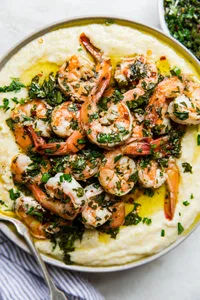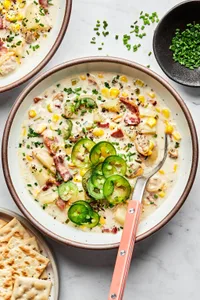Chimichurri Shrimp with Polenta is A New Kind of Soul Food.
You can stop trying to figure out what to do with those jumbo shrimp in your freezer. Say hello to our herby sautéed chimichurri shrimp and polenta recipe—and we’ll just go ahead and say ‘you’re welcome’ right now. We will also say that this is one of the simplest shrimp recipes ever, and the payoff is huge. Try making this one for your next dinner party, because it is an easy one to scale up and, thanks to a gloriously easy and delicious homemade chimichurri sauce it’s a real show-stopper of a dinner.
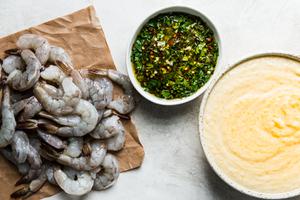
Shrimp Shopping 101: Freshness is Key!
Weirdly enough, the best way to guarantee freshness is to buy frozen shrimp. Almost all shrimp are frozen as soon as they’re caught—right on the fishing boat. This means that the “fresh” shrimp that you see in the fish case at the grocery store is actually frozen shrimp that has been thawed by the store’s fishmonger. There’s nothing inherently wrong with that, but it’s hard to know how long it has been sitting out and as far as freshness goes, you’re better off buying if frozen and thawing just as much shrimp as you need yourself! For this easy sautéed shrimp recipe, look for:
- Jumbo shrimp! The word “shrimp” is actually an umbrella term that encompasses hundreds of types of crustaceans in the decapod family. Rather than make your head spin by listing all of the various kinds of shrimp you might encounter—also, most shrimp sellers don’t bother saying the variety, so you don’t need to know them anyway—we’ll just say that (for home cooks like us) it’s the size that matters most. The best way to determine the size of the frozen shrimp you’re buying is to look at the number of shrimp per pound (this number should be clearly visible on the bag). “Jumbo shrimp” are sold in bags that have about 15-20 shrimp per pound, and that’s what you want for this easy shrimp recipe.
- Peel on! Shrimp frozen with the peel on typically will have more flavor than peeled and deveined shrimp, although it does mean a little more work for you. Peel-on frozen shrimp are also less processed, which is always a good thing.
- Easy on the preservatives. When buying frozen, it’s important (and easy) to consider any added ingredients, and to be aware that some brands of frozen shrimp are treated with chemical preservatives or added salt that you might rather avoid. Check the label and read the ingredients carefully.
- If you’re in a hurry: go ahead and buy the thawed shrimp from the fish case! Just ask to sniff it (be brave!) and if you detect any ammonia-like odors, or if the shrimp has black spots or looks a little slimy, skip it. If they smell fresh and look firm—go for it! While you’re at it, have the fishmonger peel and devein them for you, too.
- When in doubt, download the Monterey Bay Aquarium’s Seafood Watch app, which can help you determine the best shrimp to buy for both your own health and for the health of our oceans.
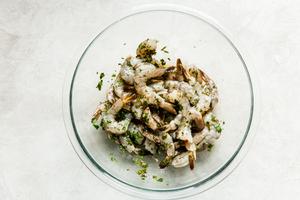
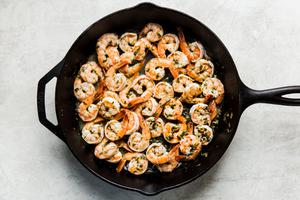
How to Clean Shrimp
Learning how to peel and devein shrimp can seem like a daunting task, but it’s really pretty simple. Also, it’s not technically necessary to devein your shrimp, so if you want to skip it, you can. The “vein” is the shrimp’s digestive tract, and it can have a little sand or grit in it sometimes, so we like to remove it. Here’s how to get your jumbo shrimp ready for the sauté pan:
- Defrost! Defrost your shrimp in a bowl of cold water in the fridge—in other words, very slowly.
- Once they're defrosted, drain the shrimp. Begin to peel the shrimp by holding the shrimp in one hand and use your other hand to peel off the legs.
- Once the legs have been removed, you can take the shrimp shell off by peeling it, beginning from where you took off the legs.
- To keep the tail on—we like to leave the shrimp tail on— just hold it firmly in place with one hand while you peel the shell of the body of the shrimp with your other hand.
- To remove the vein, hold the shrimp with the back side up. Use a sharp, small knife (like a paring knife) or a shrimp deveiner to make a shallow cut along the vein (the dark line that runs along the back of the shrimp). Once you've made the incision, use the tip of the knife to scrape out the vein.
- You’re done! Time to get cooking!
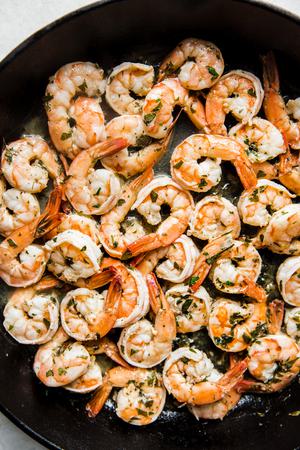
Is Shrimp Good for You?
Yes! Shrimp isn’t just high in lean protein—20 grams of protein per serving, thank you very much— it’s also a really excellent source of selenium and vitamin B12, and a decent source of iron, too. For a long time, people worried about the cholesterol content of shellfish like shrimp and crab, but nutritionists now believe that dietary cholesterol is less worrisome than previously feared. The primary thing to watch out for is excess sodium—if you’re buying frozen shrimp, remember to check the label for the ingredients! Different brands of frozen shrimp will have undergone different levels of processing, and some are preserved using saltwater, which can mean that the shrimp are a little higher in sodium than you’d want them to be.
How to Cook Shrimp on the Stove
We’re letting the homemade chimichurri sauce do all the heavy lifting here—it gives the shrimp loads of flavor, and the oil in the chimichurri means that you don’t even need to add butter or oil to your pan before you sauté the shrimp. Here’s how to make sautéed shrimp:
- Toss the shrimp in about half a cup of the chimichurri sauce until each jumbo shrimp is nicely coated.
- Heat a large dry skillet—we used cast iron, but any skillet you love will work—over medium-high heat.
- Carefully (so as to avoid too much splatter) lay the shrimp in the pan. You should hear a sizzle when they hit the pan. If you don’t, give the pan more time to warm up.
- Cook the shrimp until they turn pink, turning them over about halfway through cooking. This whole process only takes about three minutes, so keep a close eye on the shrimp. If your pan is small, you may want to work in batches.
- Serve the chimichurri shrimp over creamy polenta with a spoonful (or two!) of extra chimichurri sauce over the top.
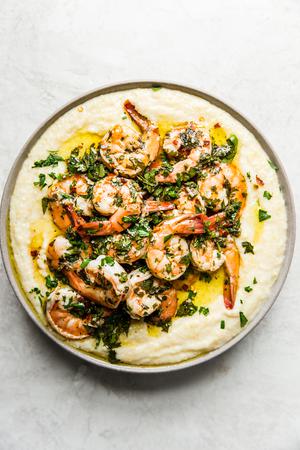
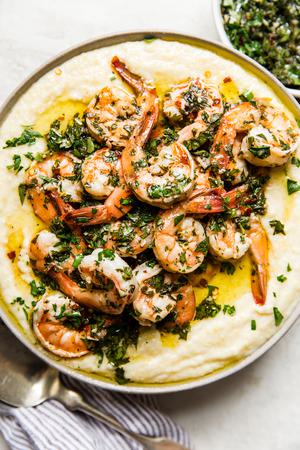
Tools You’ll Need:
- Shrimp deveiner—not a must, but nice to have if you’re someone who really loves shrimp.
- A cast iron skillet, or your favorite sauté pan.
- A sharp knife.
Other Foolproof Shrimp Recipes:
Shrimp for dinner always feels kind of special right? Plus, it’s healthy and easy! Bookmark these for your next dinner party:
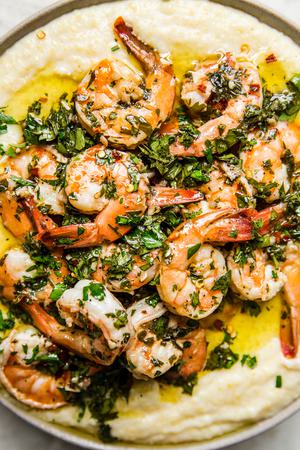
Best Sautéed Shrimp Recipe Ever!
At least we think so, and we hope you do, too. Let us know how they worked out for you! Snap a photo of your chimichurri shrimp and maybe even a video of the beautiful people you feed it to. Tag us on Instagram using @themodernproper and #themodernproper. Happy eating
